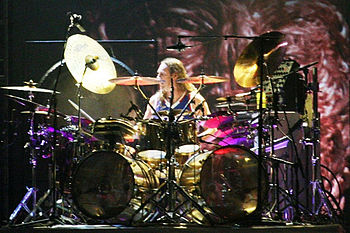- Synesthesia Mandala Drums
-
The Synesthesia Mandala Drum is an electronic drum pad developed by Vince DeFranco and drummer Danny Carey from Tool.[1] It has 128 strike position detection rings from its center to its edge, along with 127 levels of velocity sensitivity. In its current iteration, version 2.0, both values are transmitted via USB MIDI to a computer, where they can be interpreted by any MIDI software. The Mandala also includes its own "Virtual Brain" software. The current USB/software system replaces a hardware brain that the version 1.0 Mandala system had employed. The pad can be struck with drum sticks or fingers and hands.
Contents
Technology
The Mandala pad represents membrane sensor technology that was developed over several years by Vince DeFranco and was released to the public in May 2006.
Because a Mandala surface is divided into 128 position rings and can detect 127 strike velocities (greater than 0) it can produce up to 16,256 (128 x 127) individual triggers.[2] For practical playing the pad can be concentrically divided into as little as one or as many as seven playing zones via its Virtual Brain software. The individual zones, position rings, and velocity levels can be used to trigger different instruments, effects parameters, or volume changes.
The newest version of the Mandala, v2.0, is a MIDI controller which uses a computer as its sound source. When the pad is struck it sends a MIDI trigger note with velocity as well as position values across a USB cable into a computer. A Virtual Brain program is included with v2.0 and has a set of included instrument samples and two effects racks. Any parameter of any effect can be controlled by the position (0-127) or velocity (0-127) of a surface strike, resulting in effects such as bending pitch, changing delay time, or increasing reverb as the pad is played from center to edge, as examples. The position controller can be scaled to the player's liking.[3] Preset sound configurations are included with the Virtual Brain and more can be saved by the user. Drummers can also modify panning and note settings for each zone. The Virtual Brain program is not required to play the Mandala because the pad is a MIDI controller that can trigger any software that accepts MIDI input.
Version 2.0 demonstrates the resolution of its sensitivity by including over 3000 position and velocity based samples of a single vintage snare drum which get laid out over the Mandala surface for an accurate playing representation.
Version 1.0 of the Mandala included a standalone hardware 'brain' with an onboard sound chip and effects. That version is no longer available.
External links
- Synesthesia Manufacturer website
- Mandala YouTube Channel Demos and performances
- Danny Carey Co-developer and user
- Mandala Drums Google Group User community
Endorsers [4]
- Danny Carey Tool
- Pat Mastelotto King Crimson
- Will Calhoun Living Color
- Matt Chamberlain Pearl Jam/Bowie/Peter Gabriel/Tori Amos/Critters Buggin +
- Aaron Harris ISIS
- Joe Barresi Producer, Engineer: The Melvins/Tool/Queens of the Stone Age/Weezer/Wolfmother +
- Jaron Lanier Computer Scientist/Composer/Visual Artist/Author
- Lol Tolhurst The Cure/Levinhurst
References
- ^ Modern Drummer Magazine, "Q&A Section - Danny Carey", November 2006
- ^ Electronic Musician Magazine, "Quick Pick: Synesthesia Mandala 2.0 (Mac/Win)", July 2008
- ^ Harmony Central: Synesthesia Presents The Mandala Drum, Designed With Danny Carey Of Tool
- ^ Endorsee Page http://www.mandaladrum.com
Categories:- Electronic musical instruments
Wikimedia Foundation. 2010.

